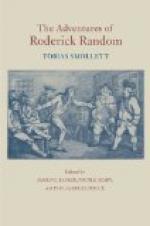|
This section contains 9,486 words (approx. 32 pages at 300 words per page) |

|
SOURCE: "Smollett: The Satirist As a Character Type," in his Satire and the Novel in Eighteenth-Century England, Yale University Press, 1967, pp. 186-208.
In the following excerpt, Paulson focuses on Smollett's later novels, arguing that while earlier works like Roderick Random define what it is to be a satirist, later novels, such as Ferdinand Count Fathom and, ultimately, Humphry Clinker, represent Smollett's greatest maturity as a writer and contain his most realistic character portrayals.
Gi; the Search for a Satirist =~ Sthe Search for a Satirist
After Peregrine Pickle each of Smollett's novels is to some extent a search for a satirist, an exploration into the function and meaning of the satirist, just as each contains a solution of some kind to the problem of a satiric form. Roderick, Peregrine, and Crabtree [a character in Peregrine Pickle] offer three solutions to the problem of the satirist and his function: beginning...
|
This section contains 9,486 words (approx. 32 pages at 300 words per page) |

|


